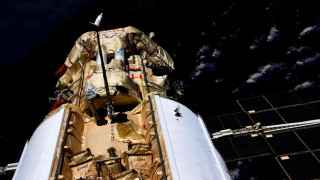
Researchers believe they have pinpointed the location a meteor, up to 2km across, impacted in northwest Scotland.
Scientists have suggested there is a secret meteorite crater beneath the sea of The Minch strait in northwest Scotland.
Researchers from the universities of Oxford and Aberdeen have called for a full geophysical survey of the strait to identify the ancient crater.
A crater and meteorite impact were first proposed in 2008 when geologists discovered peculiar rocky debris in the Scottish Highlands which could only have been created by a meteor impact.

The Minch strait in northwest Scotland where the crater is believed to be. Pic: Google
Dr Ken Amor of the University of Oxford believes he has pinpointed the exact location of the site which he expects to be buried beneath the seafloor.
The evidence gathered suggests the impact took place 1.2 billion years ago, when the Earth looked very different from how it does now.
Known as the Mesoproterozoic era, this was when one of Earth's ancient super continents called Columbia existed, and when sexual reproduction first began to evolve instead of asexual reproduction.
Among the key evidence for the meteor are a group of sandstone rocks on the eastern side of the strait known as the Stac Fada Member.
These enormous rocks - some up to 15m (49ft) thick - are believed to have been ejected from the ground when the meteor - itself possibly up to 1.2 miles (2km) wide - struck.
The sandstone rocks contain shocked quartz and accretionary lapilli - rare rock formations which can only be created in volcanic incidents or meteor impacts.
"If you imagine debris flowing out in a big cloud across the landscape, hugging the ground, eventually that material slows down and comes to rest," Dr Amor explained to the BBC.
"But it's the stuff out in front that stops first while the stuff behind is still pushing forward and it overlaps what's in front," he explained.
"That's what we see and it gives us a strong directional indicator that we can trace backwards," the scientist added.
"Also, we've examined the orientation of magnetic particles within the fabric of the rock at several locations, and this too allows us to triangulate back to an origin," the researcher told BBC News.
These lines all converge at a point in the strait where the researchers hope to do their survey.











Leave a comment